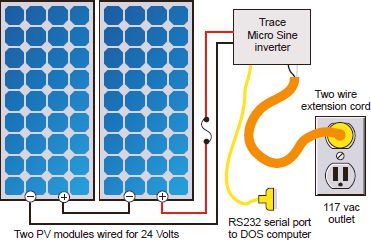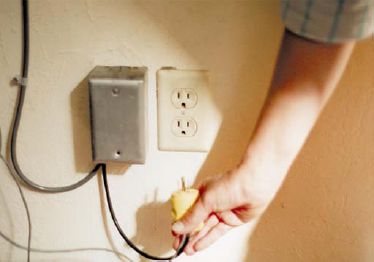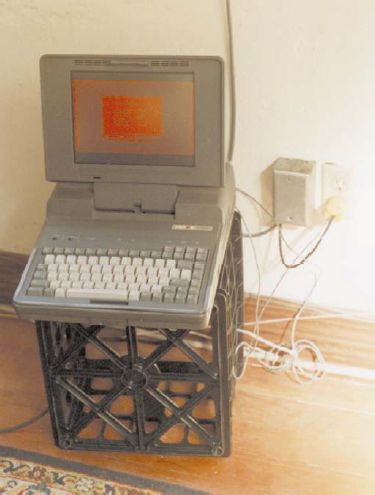

Click here to download the original PDF of this article. [Local Mirror]
It was a bright and calm spring morning. Two shadowy figures
emerged from an unmarked van. It was so plain, so ordinary, that
if anyone had been around, they would not have noticed the
activity on the otherwise deserted city street.
One person was carrying a long case with a handle. The form
quietly stepped across the sidewalk and glanced in both
directions. In a graceful, practiced manner, a key was eased into
the lock of the building. The figure slipped inside so quickly
that it seemed as if no one had even been there.
The other person moved cat-like, gently closing the side door of
the van. In through the unlocked door of the building, the second
was soon behind the first— carrying a thin but somewhat unwieldy
cardboard box about four feet square. It was carried as if it were
precious cargo, like an expensive 17th century painting by one of
the masters. The door clicked shut, and locked.
They were pros. This was guerrilla solar.
Chapter
One
Earlier this year, we made a toll-free phone call to Alternative
Energy Engineering (AEE) in Redway, California. A new solar
product was on the market, and we were excited to check it out. We
ordered the new “AC Module.” This 108 Watt 24 Volt PV panel has
Trace Engineering’s Micro Sine inverter glued to the back. The
inverter box on the module back is not much larger than the
junction box itself. The inverter is pre-wired into the module’s
junction box, and has a long, thin, four-wire cable coming out of
the side. A standard wall plug is wired onto the end of two of the
wires, and then inserted into an ac receptacle inside the
building.
Our intentions are honorable, but less than legal. We did not tell
the utility that we were going to feed homemade electricity back
into their power grid. This wasn’t a decision arrived at lightly.
Any revolutionary action should have all of the potential
consequences weighed carefully before proceeding. In this case, we
knew the risks would be minimal—unlike blockading a nuclear power
plant where arrest was likely. We felt that the worst scenario
would be the utility shutting off our power until we de-installed
the illegal PV system.
Safety Isn’t the Issue
Every utility puts high priority on making things safe for their
line workers. However, utility management has begun to use safety
as an excuse to make it difficult for us to install intertie RE
systems. The power industry doesn’t fear lack of safety, they fear
the revolutionary renewable energy movement. They fear that they
will slowly lose control over their one-hundred-year power
generation monopoly. They have good reason to fear people like us,
but they can only delay the inevitable.
At a minimum, utilities require an expensive, lockable disconnect
to keep your power out of their grid while they are working on it.
The supposed problem is that a PV system feeding power to the grid
could keep doing so when the grid goes down. This would put the
line workers in jeopardy of being shocked when they are not
expecting live powerlines. But modern intertie inverters are
designed to sense the presence of grid power, shutting off when
the grid does.
Imagine that there are two intertie systems in a neighborhood.
When the grid goes down, what if they sense each other and
continue feeding power? What happens if the load in the
neighborhood is equal to what the inverter can put out? When an
inverter continues to run when the grid goes down, it’s called
“islanding.” PG&E, a California utility, ran extensive tests
on Trace’s SW series of intertie-capable inverters. They found no
circumstances where these inverters would continue running when
the grid went down—they do not island. Yet utilities, even
PG&E, continue to require a disconnect on every intertie
system installed. You know the real reason why.
Some utilities also require multi-million dollar insurance
policies on the intertie. Those two requirements are often enough
to discourage folks from installing on-grid systems.
Is this fair? Is it OK? No, and it rubs us just wrong enough to
decide to do it without permission, without disconnects, and
without additional insurance. Hence, guerrilla solar.
The Installation
Our installation was easy and fast. We lag-screwed a length of 1/4
by 2 by 2 inch steel angle iron straight up the side of our
building. We left enough length above the roof line to be able to
seasonally adjust the module tilt. Then, we bolted the backing
from a pole mount rack to the AC Module, leaving out the part that
would normally fit over the pole. Since our building faces nearly
south, we were able to bolt the rack directly to the angle iron.
Not being engineers who can calculate wind loads on paper, we
field-tested the mounting system. We wiggled it back and forth as
if it was blown by a gusty wind. There was too much flex in the
hefty angle iron, because it extended a fair distance above the
topmost lag screw. We added a brace from the top of the post to
the side of the building. This created a solid triangle supported
in the direction of likely wind load. With the brace, the angle
iron barely moved when we pushed hard against the module. We were
satisfied.
Next, we cut the inverter output cable. We rewired it through a
waterproof box mounted just below the module. This way, we can
remove the AC Module without having to deal with the long cable
that snakes down and through the outer wall. We put a standard
household plug on the two ac output wires at the inside end of the
long four-wire cable.
 Above: The Micro Sine on the back of the 24 Volt PV. |
Below: Wiring the Trace
Micro Sine |
We
(Kinda) Inform the Utility
As we were working on the installation, a utility line crew showed
up to work on some underground cable in the alley below. The next
time we had to go down to get more hardware, we stopped to say
hello to the hardhats. We took the opportunity to point up to the
newly-mounted PV module and said, “Look, friends, we are putting
up a solar panel.” Their reaction was predictable. They looked up
with slight curiosity, while some nodded and some grunted a minor
interest. They looked back in their hole, went back to work, and
left us to our task.
So, we had shown the utility our illegal installation. Would
telling their worker bees be enough to satisfy the utility that we
had done proper notification? Would word of our illegal system
likely find its way back to utility management? No, but it was
enough to give us a great anecdote while spreading the tale of our
guerrilla solar electric system.
The Other Two Wires
We plugged it in, and our installation was fait accompli. We
wanted to find out if it was working, but how could we tell? 100
watts peak, in a serious load like our building has, wouldn’t show
a noticeable reduction in the wheel speed of the utility's kWh
meter. We could have temporarily put an amp meter in series with
one leg of the wire, but there was another method available.
Every Micro Sine inverter has an internal data collector. It
doesn’t matter whether the inverter is mounted on an AC Module or
not. It tracks real-time DC module voltage, ac output voltage,
current, watts, and total watt hours. It also measures the
temperature where the inverter is glued to the PV module. An
optional serial port computer interface module is available with
special software to access the data. The second set of two wires
coming out of the inverter hook up to this interface module.

Unfortunately, the software that came with the module is only
for PCs, and not for Macs. It runs under MSDOS, but is not
Windows-based. We installed it on a Pentium laptop and ran it in
DOS mode. We hooked up the interface, but could not get the
software to find the inverter. We had a bad experience calling and
emailing Trace to find out the scoop. We asked the voicemail tech
support to call back with information on the Windows version of
the software that was supposed to be available. All in all, we
left three messages in three different voice mailboxes, but no one
ever called back.
Email was answered, but the person who replied didn’t pay
attention and answered the wrong question. Finally, the light bulb
went on—a Trace rep told us that the software for Windows was not
available. Trace, if only your tech support matched the quality of
your equipment. Hopefully, under Trace’s new owners, tech support
will improve and the equipment quality will not suffer.
Contrary to what we were told, we had heard from a couple of other
sources that Windows software was available. These inverters had
been around for a while before Trace picked up the US rights. They
are not Trace-designed inverters; they were designed and
originally marketed by OKE-Services in The Netherlands.
We did a search on the World Wide Web. Soon, we had the software.
We loaded the program on a Pentium laptop. OKE had delivered the
US version of their software, but we still couldn’t get it to
work. We gave up on finding the Windows software.
In the meantime, we had successfully installed the DOS-based
software on an ancient 80286 portable computer that belongs to a
comrade. It ran like a champ, giving access to all of the inverter
functions and information that can be had through the software. It
turns out that the software and interface is capable of collecting
information and managing the online status of lots and lots (127)
of these inverters, not just our measly 100 watt system.
Additionally, OKE publishes the information on how to access the
data communication functions of the inverter, so that folks with
technical capabilities can write their own software to do more and
better data logging.

The
Data
There it was on the computer display, proof that the guerrilla
solar electric system was making power. And hang the utility—it
was done safely for the line workers, and safely for the building.
After four months of use, the AC Module has offset 47,354
watt-hours of consumption in our building. It’s a small amount—at
ten cents per kWh, that’s less than $5. It would take a lot of
time to make up for our expenses, but we are not really interested
in payback time. We are interested in contributing our fair share
to a more just, distributed power system. Oh yeah, we also get a
kick out of pulling one over on the utility.
Yesterday started very overcast, and the inverter was putting out
only 9 watts. Today after the fog burned off, we have seen close
to 75 watts. On a sunny day with no haze, we have seen it put out
just above 82 watts.
AEE says that the inverter will handle up to 130 Watts of PV, and
that the UL listing should be complete and on any inverters
manufactured after August, 1998. On the OKE website, it says that
their 300 watt inverter “is” due out in 1997, but there is no
indication of availability yet. In fact, that web site hasn’t been
updated since August, 1996.
|
Guerrilla
Solar Costs
|
|
You can do this too. We hope you do—and we want to hear about
your experiences. The Micro Sine inverter is not the only way. The
same thing can be accomplished on a much larger scale. We’d like
to try a Trace SW2512 inverter, an array of eight or more 100 Watt
modules, a small battery bank and charge controller for when the
grid is down, and, of course, the appropriate fusing and breakers.
Our flat roof is wide enough to hide the array from nosy utility
employees and building inspectors on the ground. That brings up
the last, very important point. Most legal intertie systems are
over-built in order to satisfy the rules of the utilities and the
needs of building inspectors for unreasonably full NEC compliance.
Our small system would satisfy neither, but is very safe with its
built-in protection. It’s up to any guerrillas installing larger
systems to take the necessary safety steps, just like a
well-designed off-grid system. Don’t worry about the utility,
these inverters are safe.

Access
Authors: (Hah! Did you think it would be that easy?)
Send email to hp@homepower.com
and HP staff will pass it on when we check in.
Alternative Energy Engineering, PO Box 339,
Redway, CA 95560 • 800-777-6609
energy@alt-energy.com
Web: www.alt-energy.com
OKE-Services • Web: www.euronet.nl/users/oke/
Trace Engineering, 5916 195th St. Northeast,
Arlington, WA 98223 • 360-403-9513
Fax: 360-403-0541
Web: www.traceengineering.com